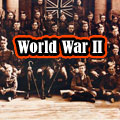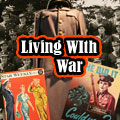Every Kitchen is an Arsenal
Catherine C. Cole
Fundraising
Reprinted with permission of the author and publisher of For King and Country: Alberta in the Second World War For a nation just pulling out of the Great Depression, financing the war was a critical task. Popular support was essential, and vast sums of money were raised throughout the province. For example, the first Red Cross drive raised $80,000 in Edmonton and $130,000 throughout northern Alberta; the provincial goal of $150,000 was more than doubled. Smaller-scale initiatives such as bake sales, card parties, concerts, raffles, teas, and dances were conducted by women's agencies for related causes. They established funds with names such as the "Emergency War Fund", "Russian Fund", "Jam for Britain", "Overseas Cigarettes Fund", "Home Comforts Fund", "Navy League Fund", and "Seeds for Britain".
For a nation just pulling out of the Great Depression, financing the war was a critical task. Popular support was essential, and vast sums of money were raised throughout the province. For example, the first Red Cross drive raised $80,000 in Edmonton and $130,000 throughout northern Alberta; the provincial goal of $150,000 was more than doubled. Smaller-scale initiatives such as bake sales, card parties, concerts, raffles, teas, and dances were conducted by women's agencies for related causes. They established funds with names such as the "Emergency War Fund", "Russian Fund", "Jam for Britain", "Overseas Cigarettes Fund", "Home Comforts Fund", "Navy League Fund", and "Seeds for Britain".
The War Charities Act of 1939 regulated the agencies authorized to conduct fundraising for the war effort. Six months into the war over 400 war-service organizations had registered in Ottawa under the act. Attempts to coordinate the efforts of the disparate groups were critical. In Edmonton, when twelve organizations met to co-ordinate services, "several speakers warned that the public was becoming irritated by the increasing number of war service appeals and emphasized that it was advisable to make one co-ordinated appeal".23 Coordinated fundraising for social services in Edmonton led to the establishment in 1941 of the "Community Chest", the forerunner of the United Way.
Fundraising efforts were sometimes coordinated beyond the local level. For example, Alberta branches of the IODE participated in a national effort to raise $100,000 through a "buy-a-warplane campaign" to purchase a Bolingbroke bomber. Similarly the City of Edmonton, Alberta collaborated with the City of Edmonton, England, to raise $25,000 to donate a Spitfire to the Royal Air Force. In 1941, six national agencies, including the YWCA and the IODE, cooperated to form the Canadian War Services Fund Campaign, the only campaign then authorized to collect funds for Canadian men in uniform.
"Victory Bond" campaigns held at intervals throughout the war reached both workers and those at home as people were encouraged to buy bonds to help raise the funds required to maintain the armed forces. Individual women took on projects to raise funds to purchase Victory Bonds. For example, Mrs. MacCrimmon kept hens at Fort Saskatchewan and bought bonds with her egg-money. In Edmonton, over 600 women canvassed door-to-door, reaching other women in their homes. "[Whatever] their responsibilities, they are out to win this war and feel that the War Savings campaign is one of the most concrete ways of showing what they are made of."24
Women in Paid Labour
Women entered the paid labour force in greater numbers than ever before, and in numbers not reached in the postwar years until the 1960s. The Second World War marked the beginning of the urbanization of the population of Alberta; a part of that shift consisted of young women moving to the cities to take temporary positions that had opened up because of the war. For example, 200 Edmonton women enrolled in the first mechanics class offered by Dominion Motors Ltd. as part of the wartime Women's Auxiliary Motor Service Plan.25 When the first 25 women graduated, Mr. Frederic Webster of General Motors said: "As your fathers, brothers or sons lay down their peace-time jobs to take up the fight you will have equipped yourselves to step into their positions and release them for the grimmer tasks of war."26
Whether it was a case of taking the civilian jobs of men who had enlisted, or working in plants on government contracts, women were anxious for the opportunity to serve their country, to fulfill a personal desire to work outside the home and to provide much needed income for their families. While the West received relatively few war contracts compared to Central Canada, such contracts were significant to the Albertan economy as their value exceeded $20,000,000 annually. Edmonton lobbied Ottawa to establish war industries locally, and firms that received war contracts included Aircraft Repair Ltd. and the Great Western Garment Company [GWG].
Aircraft Repair Ltd., with its motto "To keep 'em flying", assembled and repaired Avro Anson and Harvard airplanes, and handled maintenance and overhauls on 25 to 30 different types of planes, for the British Commonwealth Air Training Plan. The firm expanded from 25 to 2500 employees between its beginnings in April 1941 and October 1943. Women worked alongside men making up forty per cent of the work force. Some women, like Frances Woodruff, had a brother in the RCAF, and although unable to serve in the forces, were determined to do their part.
At GWG women also were performing an essential war service, and during the war they were unable to resign unless they enlisted in the armed forces. The firm received nearly $4,000,000 worth of government war contracts between 1940 and 1945, and up to 25,000 articles of military clothing were produced weekly. After the difficult years of the Great Depression, the war years were a time of expansion, as GWG became the largest garment manufacturing company in the British Empire. The company built an addition to its Edmonton plant at 10305-97 Street [now the Army & Navy building] to accommodate the staff needed to meet increased production quotas. During these years the firm produced a broad range of garments, including army combination overalls, army khaki shorts, army cotton battle-dress uniforms, army khaki shirts, army trousers, RCAF combination overalls, RCAF shirts, and prisoner-of-war uniforms. Of 488 workers, 425 were women. They worked piece-work, three shifts, 24 hours a day, 7 days a week. The Edmonton Journal praised their contribution in 1942.
In the fullest sense of the term, they were key war workers, ranking with the employees of munitions plants and women in the armed forces. Their job was a vital, important one, and they performed it with energy, devotion and skill.27
Notes
23. Edmonton Journal, 14 May, 1940.
24. Edmonton Journal, 2 March 1941.
25. Edmonton Journal, 10 April 1940.
26. Edmonton Journal, 15 November 1940.
27. Edmonton Journal, 18 April 1942.








